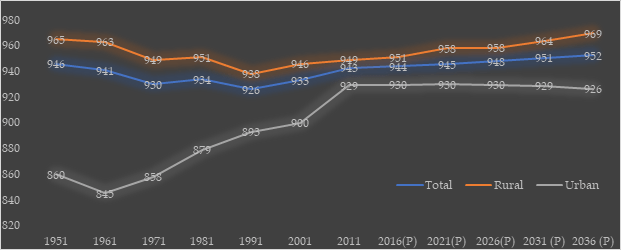
The Ministry of Statistics and Programme Implementation (MoSPI), Government of India, has unveiled the 25th edition of its annual publication, “Women and Men in India 2023.” This detailed report provides a holistic view of the socio-economic conditions of women and men in India, covering a broad range of topics including population dynamics, education, health, economic participation, and political engagement.
The publication is a vital resource for policymakers, researchers, and the general public, offering data disaggregated by gender, urban-rural divide, and geographic regions. By examining these disparities, the report aims to highlight the progress made toward gender equality and identify areas that require further attention.
Key Highlights:
- Population Projections: By 2036, India’s population is expected to reach 152.2 crore, with a slight increase in the female percentage to 48.8% from 48.5% in 2011. The sex ratio is projected to rise from 943 in 2011 to 952 by 2036, indicating a positive trend toward gender balance.
- Fertility Rates: The Age Specific Fertility Rate (ASFR) for women aged 20-24 and 25-29 decreased significantly from 2016 to 2020, reflecting a trend of family planning among younger women. Conversely, ASFR for women aged 35-39 slightly increased, suggesting that women are opting to expand their families later in life.
- Maternal and Infant Mortality: India has made substantial progress in reducing the Maternal Mortality Ratio (MMR) to 97 per lakh live births in 2018-20, moving closer to the Sustainable Development Goal (SDG) target of 70 by 2030. Additionally, the Infant Mortality Rate (IMR) for both male and female infants has decreased to 28 per 1,000 live births by 2020.
- Labor Force Participation: The Labor Force Participation Rate (LFPR) for women aged 15 years and above has seen a significant increase, rising from 23.3% in 2017-18 to 37% in 2022-23. Male LFPR also increased, indicating overall growth in economic participation.
- Political Participation: Women’s participation in national elections has risen steadily, with a voter turnout of 67.2% in the 2019 elections, surpassing male turnout for the first time.
- Entrepreneurship: As of December 2023, 47.6% of the 1,17,254 startups recognized by the Department for Promotion of Industry and Internal Trade (DPIIT) are led by women, highlighting the growing influence of women entrepreneurs in India.
The “Women and Men in India 2023” report serves as a crucial tool for understanding the demographic changes and their implications for both women and men in India. It offers valuable insights into the ongoing efforts to promote gender equity and the challenges that remain.










